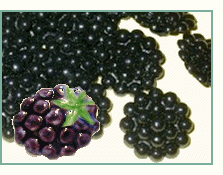black-berry / blackberry

The berry of the bramble, Rubus fruticosous; a popular name applied to different species of the genus Rubus, and their fruit. The high blackberry of America is the Rubus villosus; the low blackberry of the south, the R. trivialis. — Webster, 1882
 Blackberries were considered one of the best fruits available in the late 1800s, and could be found both cultivated and growing wild. They grew best in a moist environment where lots of organic material was present. Shoots grow up from the roots of older plants and can reach a height of ten feet or more. Montgomery County, Kansas, was reported as a fine fruit-growing county in the years after it was open to homesteading.
Blackberries were considered one of the best fruits available in the late 1800s, and could be found both cultivated and growing wild. They grew best in a moist environment where lots of organic material was present. Shoots grow up from the roots of older plants and can reach a height of ten feet or more. Montgomery County, Kansas, was reported as a fine fruit-growing county in the years after it was open to homesteading.
 Dress buttons like blackberries. In Little House in the Big Woods, Aunt Docia is said to wear a dress with buttons that look so much like blackberries that young Laura wants to taste them! Years later, Laura remembers these buttons to think about them when seeing Aunt Docia again at the beginning of By the Shores of Silver Lake. Interesting, too, is that while Laura Ingalls Wilder doesn’t write about her own mother wearing anything with these buttons on it, there are said to be buttons like blackberries in Ma’s button box described in Little House on the Prairie. Do you think one of these buttons made it onto Carrie Ingalls’ button string? The photo at left shows a collection of black buttons made of jet, and one made of glass. It is not known what Aunt Docia’s and Caroline Ingalls’ buttons were made of.
Dress buttons like blackberries. In Little House in the Big Woods, Aunt Docia is said to wear a dress with buttons that look so much like blackberries that young Laura wants to taste them! Years later, Laura remembers these buttons to think about them when seeing Aunt Docia again at the beginning of By the Shores of Silver Lake. Interesting, too, is that while Laura Ingalls Wilder doesn’t write about her own mother wearing anything with these buttons on it, there are said to be buttons like blackberries in Ma’s button box described in Little House on the Prairie. Do you think one of these buttons made it onto Carrie Ingalls’ button string? The photo at left shows a collection of black buttons made of jet, and one made of glass. It is not known what Aunt Docia’s and Caroline Ingalls’ buttons were made of.
Picking blackberries. In Little House in the Prairie, Ma, Laura and Mary pick berries amid swarms of mosquitoes, all of them there for the sweet, juicy berries. Both blackberries and raspberries (see By the Shores of Silver Lake, Chapter 22) are mentioned in the Little House books. There black raspberries that look like blackberries and red (unripe) blackberries look like raspberries, but luckily, there is a simple way to tell blackberries from raspberries. Both are made up of tiny drupes – the little balls that are the individual fruits making up a whole berry, each containing a tiny seed, which is why the berries crunch when eaten. The drupes are attached to a torus, the fleshy growing stem. When raspberries are picked, the torus remains on the plant, so the individual berries are hollow. When blackberries are picked, the torus stays attached to the berry. Also important is that blackberries are a red color when unripe, and raspberries are a green color when unripe. If you’re ever in doubt which red fruit you’re picking, check to see if it’s hollow (ripe raspberry) or not (unripe blackberry)!
Dried blackberries. Blackberries, whortleberries, currants, raspberries, peaches, plums, apples, pears, and quinces, can all be preserved by drying them in the sun, and then storing them in bags in a cool, dry place. — Catharine Esther Beecher, Miss Beecher’s Domestic Receipt Book (New York: Harper, 1850), pp. 224-225.
Canning blackberries. A old recipe for “plain canned berries” is as follows: Pick out stems or hulls if any – if gathered carefully the berries will not need washing – put in porcelain kettle on the stove, adding a small tea-cup of water to prevent burning at first. When they come to a boil, skim well, add sugar to taste (for pies it may be omitted), let boil five minutes, fill in glass, stone, or tin cans, and seal with putty unless self-sealers are used. This rule applies to raspberries, blackberries, currants, gooseberries, or any of the small berries. — Estelle Woods Wilcox, Buckeye Cookery, And Practical Housekeeping: Compiled From Original Recipes (Minneapolis: Buckeye Publishing Co., 1877), p. 102.
Stewed dried blackberries. In preparing dried or evaporated fruit for the table, the best results are attained by cooking slowly at a temperature just below the boiling point, enough water being added at first to cover the fruit. An early recipe for stewed fruit is as follows: The best way to stew any kind of fruit is to put the quantity you wish to cook into a wide mouthed jar, with enough brown sugar to sweeten it; then cover the jar close, set it in a kettle of cold water, and boil it till the fruit is tender. This preserves the flavor of the fruit. — Sarah Josepha Buell Hale, The Good Housekeeper, or The Way to Live Well and Be Well While We Live (Boston: Jordan & Company, 1839), p. 79.

black-berry / blackberry (LHP 15)
buttons like (BW 15; BPC 13, 24; SSL 1)
dried (LHP 15; TLW 18)
picking (LHP 15)
stewed dried (LHP 19)

